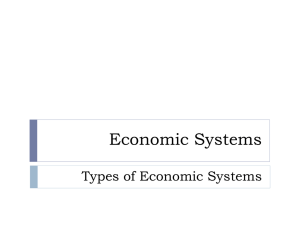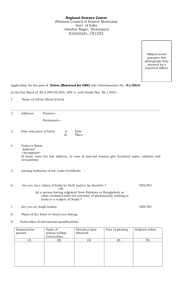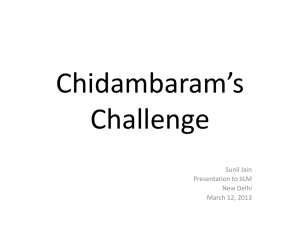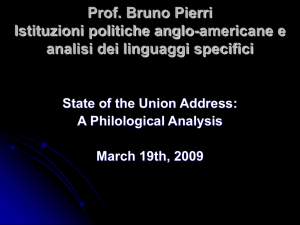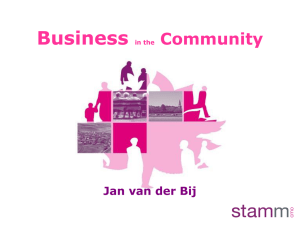Chapter 2 Economic Systems
advertisement
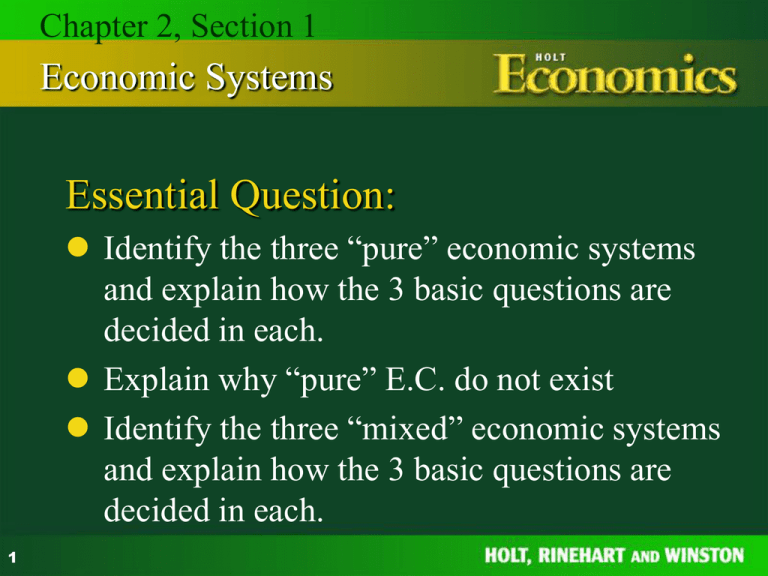
Chapter 2, Section 1 Economic Systems Essential Question: Identify the three “pure” economic systems and explain how the 3 basic questions are decided in each. Explain why “pure” E.C. do not exist Identify the three “mixed” economic systems and explain how the 3 basic questions are decided in each. 1 Chapter 2, Section 1 Economic Systems Economic Systems: All societies have an economic system or economy, an organized way of providing for the wants and needs of the people in that society Economic System-> Economy (same thing) Economic Model= possible, but non-realistic economic system. 2 Chapter 2, SECTION 1 Economic Systems What/How/Who Traditional: Traditional economic model What to produce and how to produce are determined by custom and tradition For who to produce is decided by the leaders of the community Pro’s- Everyone knows what to produce (no uncertainty Con’s- new ideas and alternatives are discouraged leading to waste. 3 Chapter 2, SECTION 1 Economic Systems What/How/Who Command: Command economic model All three basic economic questions are answered by a central authority (govt.) The advantages- Major changes in production can happen quickly, little uncertainty about what to produce (govt. tells you what to produce) 4 Chapter 2, SECTION 1 Economic Systems What/How/Who Command (cont.) The Disadvantages: Consumer needs not met Little incentive to work hard 5 Chapter 2, SECTION 1 Economic Systems What/How/Who Market: 6 Market economic model 3 basic questions answered by private producers and consumers with NO interference (govt.) The advantages Can make production changes quickly Producers and Consumers are free to buy/sell (or not) Most members of this system get their needs met Variety of Goods and Services high consumer satisfaction Chapter 2, SECTION 1 Economic Systems What/How/Who Market (cont.) The disadvantages Does not provide for the needs of all in the society (only those who can afford goods or services). Does not provide enough important non-profit services such as education or health care Lots of uncertainty about the answers to the 3 basic questions (you don’t know what will be produced for you OR what you will produce) 7 Chapter 2, SECTION 1 Economic Systems What do the “models” have in common? They DO NOT EXIST In modern society, scarcity does not allow for Pure economic models where the rules are inflexible. As a result we have mixed economies based upon the economic models 8 Chapter 2, SECTION 1 Economic Systems What is a mixed economy? All MODERN economies are mixed btwn. Govt. and the people Why mixed? Both people and govt. need to give input to ensure that the needs of society are addressed Even in oppressive countries like N. Korea, people are allowed to make SOME economic decisions. There are three examples of “Mixed Economies” The differences are based on how the 3 basic economic questions are answered. 9 Chapter 2, SECTION 1 Economic Systems Authoritarian Socialism (Communism) 10 In this Economy, the govt. makes almost all economic decisions and controls all the factors of production. The govt. answers most of the 3 basic economic questions based on the NEEDS of ALL members of society This system puts the needs of all above the wants of any. Chapter 2, SECTION 1 Economic Systems Capitalism 11 In this Economy, the people make most of the economic decisions with limited oversight by the government. The factors of production are owned by individuals who produce based on what makes the most profit (usually what satisfies the greatest needs of society). Since individuals control the production decisions, they also control the price meaning that sometimes people do not receive the goods/service that they need b/c they cannot afford it. Chapter 2, SECTION 1 Economic Systems Democratic Socialism This economic system is seen as being in the middle of communism and capitalism. Some of the factors of production are owned by govt. and some are controlled by individuals. The idea is that certain products such as education or health care are universal and as such should not be limited to only those who can afford it. 12


